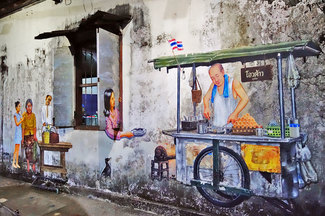BO SANG UMBRELLA VILLAGE

Not too far outside northern Thailand’s largest city, Chiang Mai, lies the little village of Bo Sang, famous for producing the beautiful paper umbrellas that have become a Thai cultural symbol and famous the world over.
These unique hand-painted umbrellas are made from Saa paper, derived from the bark of the Mulberry tree, a fast-growing tree common in Southeast Asia. The fibres of the Mulberry bark are longer than traditional paper-making pulp which gives them greater strength and durability but still remain remarkably lightweight.
 Specialist skills at each stage of the process
Specialist skills at each stage of the process
Mulberry trees of course are widely cultivated by Thai silk makers for their leaves which feed the silkworms. But the Mulberry tree has a strange characteristic. Each year, just after the end of the rainy season, they shed their bark, which the locals collect and use in their paper-making industry. The bark comes away easily without damaging the tree and so is the quintessential renewable resource.
In the traditional hand-made method the bark is boiled in large vats of water mixed with ash to separate the fibres in the bark and turn them into a thin pulp, a process which takes a few days. A wooden frame with a fine screen on one side is then dipped into the paper and the water gently drained off to leave a thin layer of matted fibres spread across the screen.
 Joyful ornament in the making
Joyful ornament in the making
This is done several times to achieve the desired thickness before the screen is laid out in the sun to dry. The dried sheet of paper is then peeled away from the screen. Sometimes natural dyes are added, petals or even gold thread. Nowadays most of the Saa production is made using machines to make the pulp after which the process of paper production is fairly similar and uses frames laid out in the sun to dry.
As you wander through the town you are left with the impression that the entire population seems to be involved in some way or other in the creation and marketing of umbrellas of all sizes from cocktail umbrellas to large parasols for the garden – the paper is surprisingly waterproof. But, to see how the umbrellas themselves are created you must head to the umbrella factory where you can watch the entire process from start to finish. Highly skilled artisans in a craft version of an assembly-line operation work at various stations, each one of which you can visit and observe these craftsmen and women demonstrate their marvellous skills and techniques.
 Deft strokes from a practised hand
Deft strokes from a practised hand
All the parts of the umbrellas are made from natural resources, bamboo, soft woods and natural latex varnish. The colours used are all derived from natural sources, mainly plants and tree bark, although acrylic paint has now become much more popular.
 A subtle elegance skilfully rendered
A subtle elegance skilfully rendered
The origins of this particular craft and how it came to be Bo Sang’s principal industry are rather obscure, as is often the case in Thailand. It is said that a wandering Monk, born in Bo Sang, returned from Burma, where he learned the art, and began to teach it to others. From these beginnings it appears that the entire town became involved, initially as an activity done after the annual harvesting was finished.
Every year on the third Friday in January the Bo Sang Umbrella Festival takes place. The whole village and people from the surrounding district hold parades and exhibitions and there is a Miss Bo Sang pageant at the end of which a winner is crowned. It is a vibrant, colourful spectacle as you watch the parade wend its way through the narrow main street, with dancers to the fore and people on bicycles carrying umbrellas of course!
These gorgeous parasols epitomise the artistic skills for which Thais are famous and as with much of Thai culture there is an emphasis on creating an aesthetic appeal for functional objects, a pride in cultivating and preserving a tradition and an exuberance and joy in the act of creating works of stunning beauty.










of collaborative energy




Before proceeding to use the website please carefully ready our Terms and Policies
I accept Diwerent's Terms and Conditions and Privacy Policy













